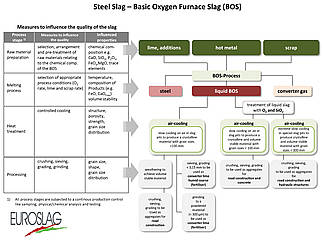Basic oxygen furnace slag
Basic oxygen furnace slag - BOS (also called LD-converter slag)is formed during the conversion of hot metal from the blast furnace into steel in a basic oxygen furnace. In this process the hot metal is treated by blowing oxygen to remove carbon and other elements that have a high affinity to oxygen. The slag is generated by the addition of fluxes, such as lime[stone] and/or dolomite that combine with silicates and oxides to form liquid slag. Some amounts of scrap are also added in order to control the temperature of the exothermal reactions.
When the reaction process is complete, molten crude steel collects on the bottom of the furnace and the liquid slag floats on top of it. The crude steel and the slag are tapped into separate ladles/pots at temperatures typically above 1600°C. After tapping, the liquid slag in the pot can further be treated by injection of SiO2 and oxygen in order to increase volume stability. The molten slag is then poured into pits or ground bays where it air-cools under controlled conditions forming crystalline slag. In order to adjust the required technical properties for a specific use, different measures like weathering, crushing and/or sieving are performed on the crystalline slag.
Basic oxygen furnace slag has increased skid resistance and high level of strength (described by the impact- and crushing value) compared to natural rocks (e.g. basalt) and thus makes it an ideal aggregate for road constructions and surface layers for high skid resistance. Other fields of application are the production of fertilizers or the use of armourstones for hydraulic engineering.

